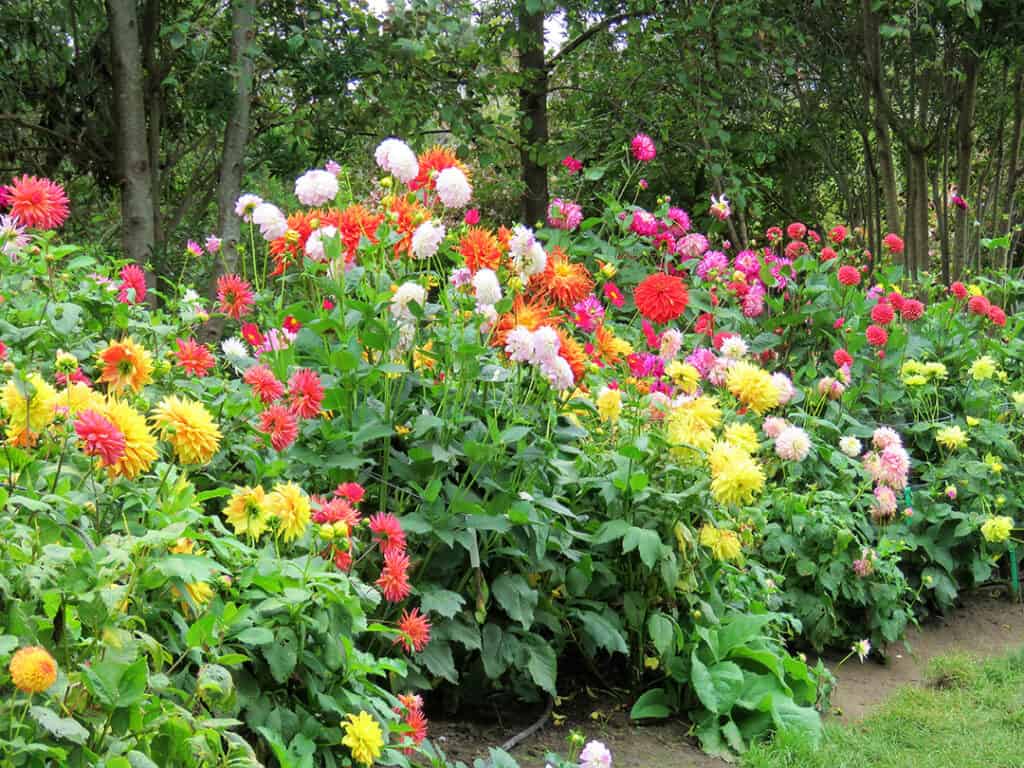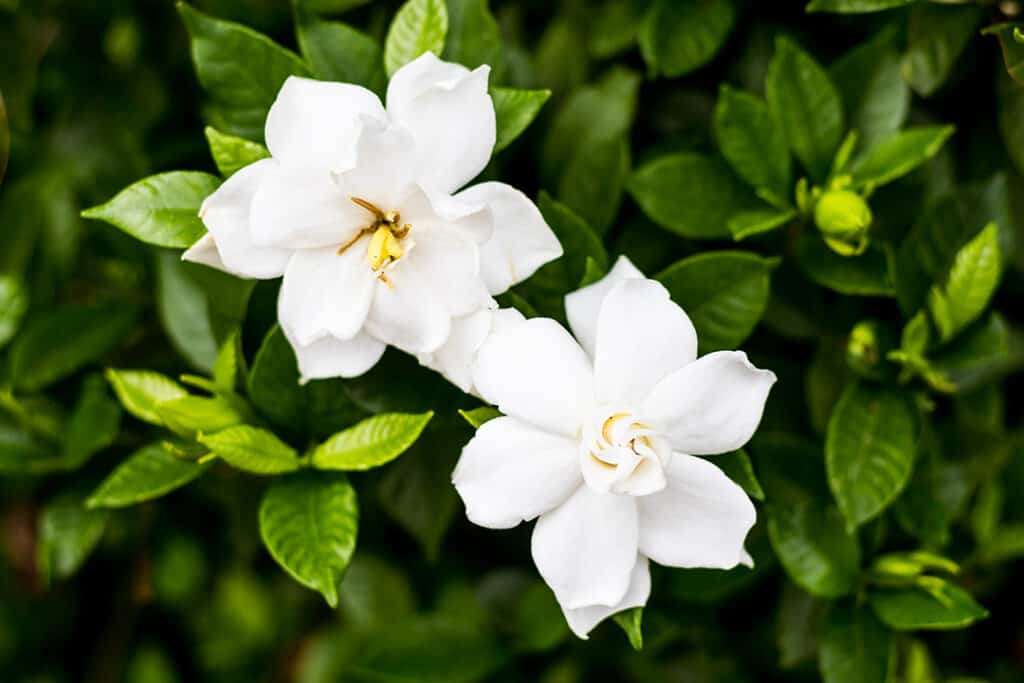If you’ve been spending a lot more time than usual at home this summer, outdoors on your deck or patio, around the pool, in the pool house or gazebo, on the porch or in the sunroom, you’ve probably wanted to make it a place where you really enjoy spending time. No doubt you have comfortable furniture there, and a place to dine. Perhaps you have a fire pit or fountain. And maybe you’re longing to escape to a tropical paradise. Who knows if we’ll be able to head to the islands this winter? But you can create your own tropical getaway right here outside your house, on your deck or patio, or in your garden. We have the water nearby, and that magical East End light around us, so all you need is the lush surroundings.

Including tropical plants in pots and tubs can turn your outdoor living space into your own little paradise. The weather is generally warm here through September and even into October, so you may still be able to find tropicals at local nurseries, and perhaps pick up some bargains. And you can certainly plan ahead for next year. Here are some ways to bring a bit of the tropics to your outdoor space.
Many East End nurseries sell tropical plants for summer gardens. Set pots of them on your deck or patio, or in a gazebo, around the pool and pool house, even in the garden for colorful, textural, seasonal accents. Here are some strategies for creating your paradise.
A lush composition needs tall things for height, like a forest canopy, bold middle ground plants for volume and lushness, flowers for brilliant color, and vines and cascaders to climb trellises and spill over the edges of pots. These strategies can work in pots, tubs and planters, or in a garden bed.
First, start with tall plants and trees for height. A tree can take center stage in a large pot, especially if it will be viewed from all sides, or if viewed from one side, place it in the back. You can find lots of choices in local nurseries – palms, ficus trees and banana plants work well in shade. In a sunnier location consider citrus trees (bushy or trained as standards with a ball of foliage, flowers and fruit atop a tall straight stem), hibiscus with flowers in warm colors, in tree or bush form, brugmansia or angel’s trumpet, which produces large, dangling trumpet flowers of white or yellow or orange (not recommended around small children or pets), or gardenias which can be found as standards and whose creamy white flowers are devastatingly fragrant.
Next, bold foliage adds lushness to the middle ground. There are elephant ears (alocasia and colocasia) and split-leaf philodendron for a shady spot, gingers, ornamental bananas, bird of paradise and canna lilies with their stalks of big, bold lily-like flowers in hot shades of red, orange and yellow for brighter places.
For nonstop color dahlias are hard to beat. They come in several forms and sizes, and a host of warm colors from pastels to brights. Cut off spent blossoms, water when needed and they will bloom all summer until fall frost shuts them down. Other good candidates include flowering vines on tripods or trellises – morning glories and their night blooming relative, moonflower, mandevilla with big, pink, trumpet shaped blossoms, richly fragrant jasmine, allamanda with yellow trumpet flowers, and exotic passionflowers in purple, white or red on graceful tendrilled vines.

To fill in space lower down, and/or to spill over the sides of pots and planters there are crotons and bromeliads (pineapple relatives) in bright red, yellow and orange, caladiums with foliage patterned in green, red, pink and white for shady spots, and lots more. Just remember that most tropical plants need water – if you are after no-care plants, consider cactus.
Stretch out in your lounge chair, with a cool drink, surrounded by the lush greenery and colorful flowers of your tropical garden, and pretend you’re in paradise.










![Introducing Goose Creek, a revitalized 14± acre waterfront estate nestled along 827± ft. of water frontage at 30 Mathews Road. Crafted in 2010 by the esteemed local builder Ben Krupinski and envisioned by the renowned architect Paul Rice, the grand 10,000± sq. ft. home blurs the lines between indoor and outdoor living. Contact @petrieteam of @compass with all rental inquiries. [link in bio]](https://hamptonsrealestateshowcase.com/wp-content/uploads/sb-instagram-feed-images/475679064_18489177286030135_5241008928583656401_nfull.webp)
![An unparalleled opportunity on Dune Road in Bridgehampton! This oceanfront contemporary beach house offers breathtaking ocean views, stunning Mecox Bay sunsets, a separate guest suite, and a gunite pool. Plus, an additional .41±-acre bayfront parcel where you can build your own paradise. Represented by @susan.breitenbach and @cutterexperience of @thecorcorangroup. [link in bio]](https://hamptonsrealestateshowcase.com/wp-content/uploads/sb-instagram-feed-images/475695248_18489040534030135_6696513711863139483_nfull.webp)
![Construction is complete at 121 Stoney Hill Road in Sag Harbor! This stunning 5-bedroom home on 1.7± acres offers nearly 4,500± sq. ft. of masterfully designed living space. Featuring an open floor plan, a chef’s kitchen with professional appliances, and a cozy den, this is the ultimate year-round Hamptons retreat. Represented by @depersiahamptons of @thecorcorangroup. [link in bio]](https://hamptonsrealestateshowcase.com/wp-content/uploads/sb-instagram-feed-images/475282908_18488852602030135_7513047926010415601_nfull.webp)
![With colder weather here, it’s time to focus on our indoor spaces—especially the bedroom. Often overlooked during the busy outdoor season, it deserves some TLC. Top designers @susanstraussdesign and @studiokestrel share tips to transform your sleeping space into a cozy retreat. [link in bio]](https://hamptonsrealestateshowcase.com/wp-content/uploads/sb-instagram-feed-images/475457035_18488712538030135_6045616466708866087_nfull.webp)
![Warm up this season with Winter Long Island Restaurant Week! ❄️🍴 Treat yourself to delicious prix-fixe menus at some of the Hamptons' top restaurants. It’s the perfect way to indulge in cozy vibes, local flavors, and unbeatable dining deals. Don’t miss out—your next favorite dish awaits! [link in bio]](https://hamptonsrealestateshowcase.com/wp-content/uploads/sb-instagram-feed-images/475003771_412763975194381_2348260318148001234_nfull.webp)

![5 Widow Coopers Path offers the perfect blend of luxury and tranquility. Located in one of the most desirable areas, this home features beautifully designed interiors, ample outdoor entertaining spaces, and the charm that only Sag Harbor can provide. Whether it’s cozy evenings inside or summer days by the pool, this is Hamptons living at its finest. Represented by @jameskpeyton of @thecorcorangroup. [link in bio]](https://hamptonsrealestateshowcase.com/wp-content/uploads/sb-instagram-feed-images/474930084_18488006128030135_2620127806058906575_nfull.webp)
